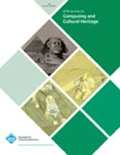
ACM Journal on Computing and Cultural Heritage
Scope & Guideline
Advancing Heritage Preservation with Cutting-Edge Technology.
Introduction
Aims and Scopes
- Digital Preservation and Archiving:
Research on methods and technologies for the digital preservation of cultural artifacts, including archival practices, metadata standards, and long-term data sustainability. - Virtual and Augmented Reality Applications:
Exploration of virtual and augmented reality technologies to enhance visitor experiences in museums and cultural heritage sites, including immersive storytelling and interactive exhibits. - Machine Learning and AI in Cultural Heritage:
Application of machine learning and artificial intelligence techniques for tasks such as image classification, content recognition, and enhancing user interactions with cultural heritage data. - User Experience Design and Evaluation:
Studies focusing on user experience (UX) and interaction design within cultural heritage contexts, assessing how technology can improve visitor engagement and learning. - Cross-disciplinary Collaboration:
Encouragement of interdisciplinary approaches that combine computing, humanities, archaeology, and cultural studies to further the understanding and representation of heritage. - Data Interoperability and Linked Data:
Research on creating interoperable data systems and utilizing linked data principles to enhance access to and integration of cultural heritage information.
Trending and Emerging
- Integration of AI and Machine Learning:
An increasing number of studies are focusing on the use of AI and machine learning for tasks such as image recognition, content classification, and enhancing user interactions, showcasing the potential of these technologies in cultural heritage. - Enhanced Visitor Experiences through Technology:
There is a growing emphasis on developing immersive experiences using virtual and augmented reality, which enhances visitor engagement and education in cultural settings. - Sustainability in Cultural Heritage Practices:
Emerging themes focus on sustainable practices in the preservation and presentation of cultural heritage, integrating ecological considerations into digital methodologies. - Crowdsourcing and Community Engagement:
Research is increasingly exploring crowdsourcing as a method for enhancing cultural heritage projects, enabling community participation and collaborative documentation. - Interdisciplinary Approaches:
The journal is witnessing a rise in interdisciplinary research that combines computing, social sciences, and cultural studies, reflecting the need for diverse perspectives in addressing cultural heritage challenges.
Declining or Waning
- Traditional Methods of Heritage Documentation:
There is a noticeable decrease in research focusing on conventional methods of documentation in favor of more advanced digital techniques, indicating a shift towards innovative approaches. - Physical Reconstruction Techniques:
Research papers that concentrate solely on physical reconstruction methods without integrating digital technologies are becoming less frequent, as the field moves towards fully digital solutions. - Basic Educational Approaches:
Studies that focus on traditional educational methods in cultural heritage, without leveraging technology or digital engagement strategies, are declining, reflecting a growing emphasis on interactive and immersive learning experiences. - Static Display Methods in Museums:
Research on static, non-interactive display methods in museums is waning, as the trend shifts towards dynamic, visitor-centered, and technology-enhanced exhibitions.
Similar Journals
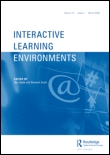
INTERACTIVE LEARNING ENVIRONMENTS
Shaping the next generation of interactive educational practices.INTERACTIVE LEARNING ENVIRONMENTS, published by Routledge Journals, Taylor & Francis Ltd, is a premier peer-reviewed journal that focuses on the intersection of technology and education, dedicated to advancing the understanding of interactive learning methodologies. With an impressive Q1 ranking in both Computer Science Applications and Education, as well as in E-learning, this journal stands out as an authoritative source of innovative research, ranking 28th in Education and 65th in Computer Science according to Scopus metrics. The journal's comprehensive scope covers a broad range of topics, from the effectiveness of haptic feedback in learning environments to the development of adaptive learning technologies, making it a vital resource for researchers, educators, and policy-makers alike. Although currently not an open-access publication, INTERACTIVE LEARNING ENVIRONMENTS provides readers with substantial insights and empirical findings critical for both theoretical and practical applications in the evolving landscape of educational technology.
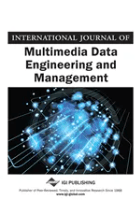
International Journal of Multimedia Data Engineering & Management
Bridging Theory and Practice in Multimedia TechnologiesInternational Journal of Multimedia Data Engineering & Management, published by IGI Global, is a pivotal platform for the dissemination of knowledge in the fields of multimedia data engineering, information management, and technology-driven methodologies. With a keen emphasis on exploring innovative approaches to data management, this journal engages researchers, professionals, and students interested in the rapidly evolving digital landscape. Although currently not designated as Open Access, the journal is accessible through institutional subscriptions, fostering rigorous academic dialogue and collaboration. The ISSN for this esteemed publication is 1947-8534 (E-ISSN: 1947-8542), ensuring its global reach and recognition within the scholarly community. By bridging theoretical perspectives with practical applications, the International Journal of Multimedia Data Engineering & Management supports ongoing advancements and drives impactful research in multimedia technologies.

Journal of Information Technology in Construction
Enhancing Construction Practices Through Technological InnovationThe Journal of Information Technology in Construction is a premier open-access journal dedicated to advancing knowledge in the intersection of information technology and construction practices. Established in 1996, this journal has emerged as a vital resource for researchers, professionals, and students in the fields of Building and Construction, Civil and Structural Engineering, and Computer Science Applications. Published by the INT COUNCIL RESEARCH & INNOVATION BUILDING & CONSTRUCTION, this journal's rigorous peer-reviewed content is designed to foster innovation and enhance the application of technological solutions within the construction sector. With a commendable reputation, the journal has secured Q1 ranking in Building and Construction and features in the top quartiles in related disciplines, ensuring its impact and relevance within academic and industrial communities. Conveniently accessible, the journal showcases high-quality research that influences both theoretical and practical aspects of construction technology, thereby contributing significantly to the field. Based in Sweden, the Journal of Information Technology in Construction stands as a crucial platform for disseminating insights that drive progress in this dynamic and evolving domain.
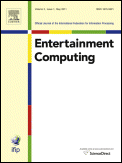
Entertainment Computing
Innovating the Future of Interactive ExperiencesEntertainment Computing, published by ELSEVIER SCI LTD, is a leading journal that explores the intersection of computing technology and entertainment, encompassing a wide range of topics from video games to interactive media. With an ISSN of 1875-9521 and an E-ISSN of 1875-953X, this esteemed publication caters to an interdisciplinary audience, including researchers, industry professionals, and students. Since its inception in 2009, the journal has achieved impressive recognition in the academic community, ranking in the Q2 quartile for both Computer Science Applications and Human-Computer Interaction, as well as Software, according to the 2023 category quartiles. The journal's commitment to high-quality, peer-reviewed research is reflected in its Scopus rankings, where it currently stands at Rank #142/407 in Computer Science Software and Rank #62/145 in Human-Computer Interaction. With its focus on innovative research that advances the understanding of how technology shapes our entertainment experiences, Entertainment Computing plays a pivotal role in fostering scholarly discussion and practical applications in the field.

Frontiers in Computer Science
Advancing knowledge at the intersection of technology and society.Frontiers in Computer Science is a premier open-access journal published by Frontiers Media SA that has rapidly established itself as a prominent platform for scholarly research in the diverse and evolving field of computer science. With a notable impact factor reflecting its high citation rates, this journal aims to disseminate innovative findings and groundbreaking studies across multiple subdisciplines, including Computer Science Applications, Computer Vision and Pattern Recognition, and Human-Computer Interaction. Since its inception in 2019, and with a consistent trajectory from 2019 to 2024, it has garnered accolades, achieving Q2 ranking in several categories and an impressive Q1 in miscellaneous areas of computer science. Researchers, professionals, and students alike are encouraged to contribute to this dynamic journal that serves as a vital resource for advancing knowledge and fostering collaborative dialogue in the global computer science community. Frontiers in Computer Science is committed to providing open access to research, promoting unrestricted sharing of ideas and fostering innovation at the intersection of technology and society.

Virtual Archaeology Review
Unlocking the Past with Innovative Virtual Techniques.Virtual Archaeology Review, published by UNIV POLITECNICA VALENCIA, EDITORIAL UPV, is a distinguished open-access journal dedicated to the dynamic fields of archaeology and conservation. Based in Spain, this journal has made a significant impact in the academic community, reflected in its outstanding Q1 ranking in Archeology and Conservation for 2023, alongside impressive standings in related disciplines such as Computer Science Applications. With an active commitment to promoting the accessibility of knowledge since 2010, it provides a platform for researchers, professionals, and students to share innovative findings and methodologies in virtual archaeology, fostering collaboration across disciplines. The journal's impact factor and its strategic focus on advancing the practice of virtual methodologies in archaeology underscore its vital role in bridging technology and heritage studies. By embracing a multidisciplinary approach, Virtual Archaeology Review not only enhances academic discourse but also drives the development of effective conservation strategies, making it an essential resource for those dedicated to the preservation and appreciation of our cultural heritage.
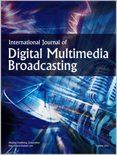
International Journal of Digital Multimedia Broadcasting
Illuminating the Path of Multimedia AdvancementsThe International Journal of Digital Multimedia Broadcasting is a leading scholarly platform dedicated to the interdisciplinary exploration of digital multimedia broadcasting, published by HINDAWI LTD. With an ISSN of 1687-7578 and an E-ISSN of 1687-7586, this Open Access journal has made significant strides since its inception in 2008, ensuring wide accessibility and dissemination of research. Based in the United States, at Adam House, 3rd Flr, 1 Fitzroy Sq, London W1T 5HF, England, the journal covers a range of topics relevant to Communication, Electrical and Electronic Engineering, and Media Technology, boasting impressive Scopus rankings that highlight its influence in these fields. As part of the Q3 category in Communication and Electrical Engineering, and Q2 in Media Technology for 2023, the journal serves a vital role in fostering the understanding of technological advancements and their applications in multimedia broadcasting. Researchers, professionals, and students are encouraged to contribute to and benefit from the journal's rich repository of knowledge, paving the way for innovative developments in this dynamic industry.

Multimodal Technologies and Interaction
Fostering Innovation in Digital User Experiences.Multimodal Technologies and Interaction, published by MDPI since 2017, is an esteemed open-access journal based in Switzerland, dedicated to the exploration and advancement of innovative multimodal systems that enhance user experience across various digital platforms. With its commitment to disseminating high-quality research in diverse areas such as Computer Networks and Communications, Human-Computer Interaction, and Neuroscience, the journal has rapidly established itself within the academic community, achieving a commendable position in Scopus rankings including Q2 in both Computer Networks and Communications and Computer Science Applications. As an essential resource for researchers, professionals, and students alike, Multimodal Technologies and Interaction fosters interdisciplinary dialogue and supports the development of cutting-edge technologies, ensuring that advancements in multimodal interaction are accessible to a global audience. Scholars can benefit from its Open Access format, allowing unrestricted access to influential studies that shape the future of technology and interaction design.

INFORMATION TECHNOLOGY AND LIBRARIES
Transforming Library Practices with Innovative Tech Solutions.INFORMATION TECHNOLOGY AND LIBRARIES, published by the American Library Association, stands as a crucial resource in the ever-evolving intersection of information technology and library sciences. With an ISSN of 0730-9295 and an E-ISSN of 2163-5226, this open access journal has been dedicated to fostering the dissemination of innovative research since its inception in 1971. Currently enjoying a Q2 ranking in both Information Systems and Library and Information Sciences, it is well-regarded within the scholarly community, reflecting its commitment to high-quality research outputs. The journal's diversified content scope—and a robust ranking of #80 out of 280 in the Library and Information Sciences category on Scopus—positions it as a pivotal platform for researchers, practitioners, and students alike. With the journals' emphasis on bridging technological advancements and library practices, it remains an essential tool for anyone looking to stay informed and engaged in these dynamic fields.

IEEE Open Journal of the Computer Society
Leading the Charge in Scholarly CommunicationIEEE Open Journal of the Computer Society is an esteemed open-access journal dedicated to advancing the field of computer science. Published by IEEE-INST ELECTRICAL ELECTRONICS ENGINEERS INC since 2020, this journal promotes innovative research and scholarly communication in a rapidly evolving technological landscape. With a notable Q1 ranking in the Computer Science (miscellaneous) category and a high Scopus percentile of 92, it serves as a premier platform for disseminating cutting-edge findings and interdisciplinary studies. The journal is committed to facilitating unrestricted access to valuable insights, fostering collaboration among researchers, professionals, and students alike. As it continues to publish impactful articles through 2024 and beyond, the IEEE Open Journal of the Computer Society remains a vital resource for anyone interested in the latest trends and developments in computer science.